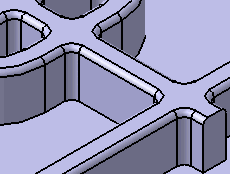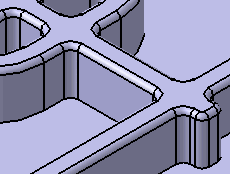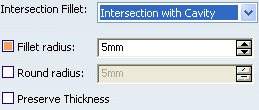More about Reinforcements | ||||
|
| |||
About Profiles
If you are not satisfied with the profile you selected, note that you can:
- Click the Profile/Surface box again and select another sketch.
- Use any of these creation contextual commands available from the
Profile/Surface box:
- Go to profile definition. For more information, see Part Design User's Guide: Sketch-Based Features: Pads: Using the Sub-Elements of a Sketch.
- Create Sketch: For more information, see Sketcher User's Guide: Creating a Positioned Sketch.
- Create Join: Joins surfaces or curves. For more information, see Generative Shape Design User's Guide: Performing Operations on Shape Geometry: Joining Surfaces or Curves.
- Create Extract: Generates separate elements from non-connex sub-elements. For more information, see Generative Shape Design User's Guide: Performing Operations on Shape Geometry: Extracting Geometry: Extracting Elements.
![]()
Distance Tab
Instead of using the Length option to define Ceiling and Opening distance, you can set:
- To Shell: Extends the reinforcement to a shellable volume in the active body, in the opposite direction of the height. The extension of the reinforcement profile must fit inside the boundaries of the shellable volume. Otherwise, no extension will occur.
- To Plane/Surface: Uses the plane or surface you select.
- To Parting Element: the parting element specified in the draft properties is used to set this limit. For this, you need to define Draft behavior in the Draft tab.
Note: It is not possible to select this option for defining First length as well as Second length at the same time.
- To Neutral Element: the neutral element specified in the draft properties is used set this limit.
Note: You cannot select this option for defining First length as well as Second length at the same time.
Selecting the Mirrored extent check box extrudes the profile in the opposite direction using the same length value as the one defined for the first length.
Click Reverse Direction to reverse the extrusion direction. Another way of reversing the direction is by clicking the arrow in the geometry area.
![]()
Direction Tab
By default, the Normal to profile check box is selected, meaning that the profile is extruded normal to the sketch plane. If you want to specify another direction, just clear the Normal to profile check box, and then select the geometrical element you want to use as the new reference.
Click the Reverse Direction to reverse the extrusion direction.
![]()
Draft Tab
If you want to define a draft angle, just click the Draft tab.
The Draft behavior box provides two options:
- None: There is no draft.
- Intrinsic to feature: You can perform a draft operation by defining the following parameters:
- an angle value. You can enter the angle value you want.
- a neutral element (defines a neutral curve on which the drafted
face will lie) that can be:
- Profile plane
- Ceiling
- Opening
- Plane/Surface
![]()
Fillet Tab
Select the Lateral radius check box to fillet lateral edges. Then, you merely need to set the radius value of your choice.
By using Lateral radius and Fillet profile ends, you can apply fillets at the intersection or at the ends of the open profile of the reinforcement. See Creating a Prism for some examples.


If you want to add an intersection fillet, select Intersection with Cavity from the dropdown list.
If you want to add material to the feature, select the Fillet radius checkbox, if you want to remove material from the feature, select the Round radius checkbox.
Select the Preserve Thickness checkbox if you want to keep the thickness applied on the feature.
You can select the Draft fillets check box from the Fillet tab. For more information, see More About Draft Fillets.